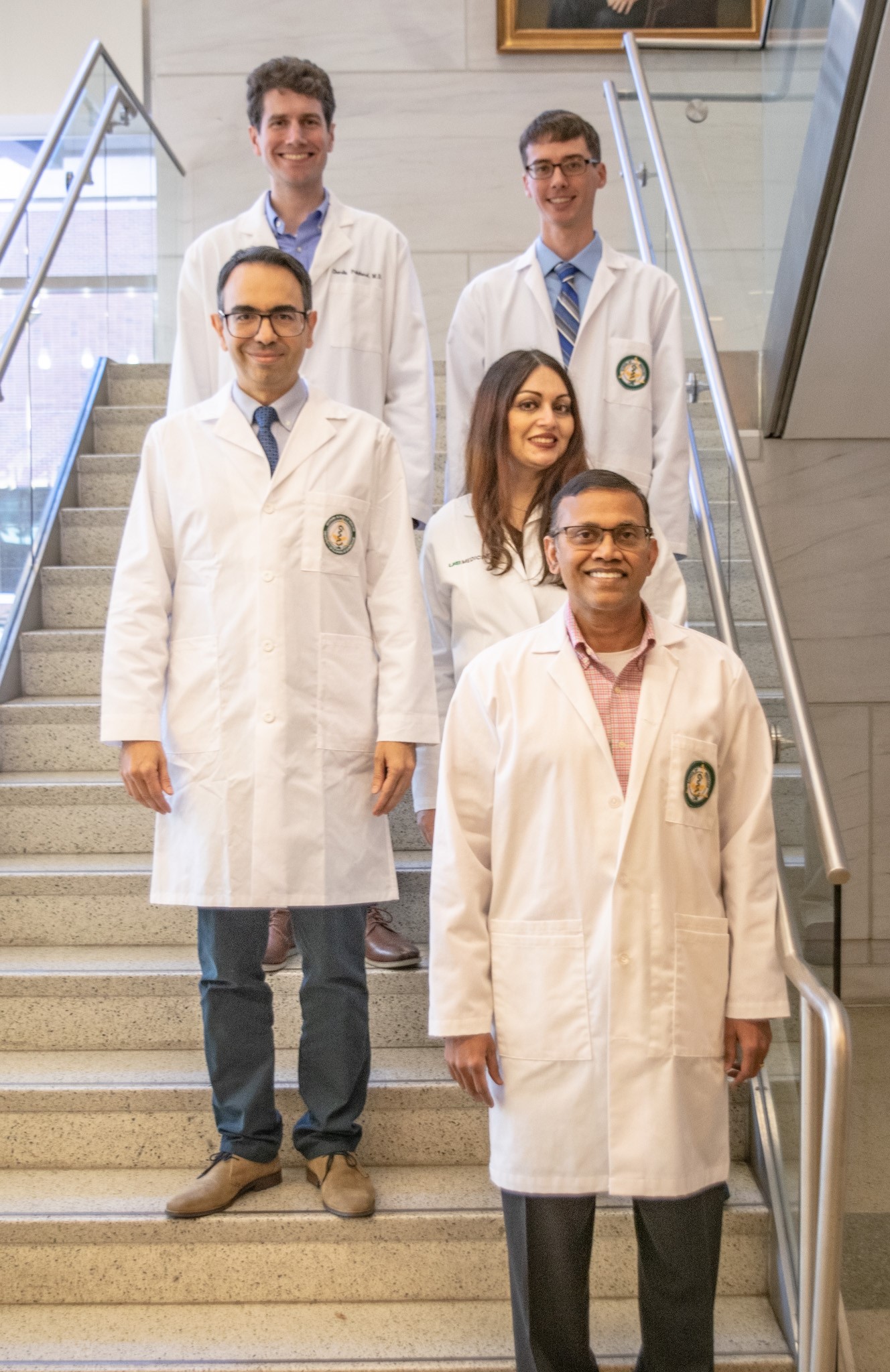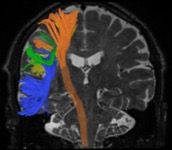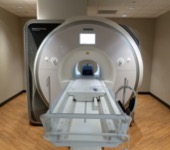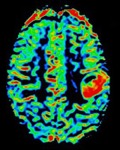 The Neuroradiology Fellowship Training program at UAB is an ACGME accredited one-year program based at the University Hospital in Birmingham and The Kirklin Clinic. Fellows will also have a one-month rotation at the Children's Hospital of Alabama.
The Neuroradiology Fellowship Training program at UAB is an ACGME accredited one-year program based at the University Hospital in Birmingham and The Kirklin Clinic. Fellows will also have a one-month rotation at the Children's Hospital of Alabama.
The one-year program provides advanced training in all neuroimaging modalities including advanced imaging techniques, such as CT and MR perfusion, MR spectroscopy, CSF flow imaging, diffusion tractography, and functional MRI. Fellows will also be exposed to advanced nuclear medicine techniques by way of multidisciplinary conferences, including brain PET with various clinical and investigation radiotracers due to the availability of an advanced cyclotron and integrated PET/MR. The close clinical and research relationship with various clinical departments results in exposure to the most advanced neuroimaging techniques in epilepsy, brain tumors, and neurodegenerative disease, amongst others. The program is a well-rounded and varied experience that can serve as a solid foundation for either academic or private practice careers.
A two-year program is available for interested individuals. The second year can be individualized to meet the interests and career goals of the second-year fellow. The curriculum is created through a series of meetings with the fellow, the program director and section chief, Radiology Residency Program director, and the chair of the department, and laid out a year in advance.
Neuroradiology Section

The Neuroradiology Section at UAB is composed of 10 full-time and two part-time fellowship-trained neuroradiologists. Four fellowship positions are available each year. Fellows fully participate in all clinical, educational, and academic activities.
Our faculty members have a broad range of experience, accomplishments, interests, and backgrounds. The experience benefits fellows by having a well-rounded exposure to recognized expertise in numerous areas, such as tumor and epilepsy imaging, head and neck imaging, and functional neuroimaging. Members of the section are well-published in a broad range of topics and also serve on editorial boards, such as the American Journal of Neuroradiology, and have co-authored popular textbooks in Neuroradiology. Combined list of publications of the neuroradiology section members is available here.
The Neuroradiology faculty have also received numerous awards in both education and research. The faculty members and fellows participate actively in annual regional and national meetings, including ASNR, ASHNR, ASFNR, and RSNA meetings. There is a strong emphasis on fellow education. More information on individual neuroradiology faculty members is available here: Neuroradiology faculty.
Equipment
 The Neuroradiology Section has access to numerous cutting-edge imaging technologies. In addition to standard 1.5 Tesla and 3 Tesla MRI units (Philips/GE/Siemens), a state-of-the-art 3T Siemens Prisma scanner is available at UAB Highlands. Boasting the most powerful gradient system of any commercial MRI unit, the Prisma allows the acquisition of unparalleled quality advanced imaging data. A 7 Tesla Siemens MRI scanner is also jointly operated by UAB and Auburn University.
The Neuroradiology Section has access to numerous cutting-edge imaging technologies. In addition to standard 1.5 Tesla and 3 Tesla MRI units (Philips/GE/Siemens), a state-of-the-art 3T Siemens Prisma scanner is available at UAB Highlands. Boasting the most powerful gradient system of any commercial MRI unit, the Prisma allows the acquisition of unparalleled quality advanced imaging data. A 7 Tesla Siemens MRI scanner is also jointly operated by UAB and Auburn University.
Over 10 CT scanners are operated by the department ranging in detector size up to 256-slice. Additional capabilities include whole-brain perfusion imaging and dual energy acquisition.
UAB also houses the T24 cyclotron, the most powerful of any academic medical center in the United States. The cyclotron is located adjacent to two state-of-the-art PET/CT scanners and an integrated GE PET/MRI allowing the simultaneous acquisition of PET and 3T MRI data. UAB is involved in numerous clinical studies in investigational radiotracers in neuroimaging including uses in neurodegenerative diseases and brain tumors. The nuclear medicine faculty work closely with the Neuroradiology faculty, including multidisciplinary conferences.
The radiology department at the Kirklin Clinic also houses a MEG, which is routinely utilized in our epilepsy and tumor patients, in conjunction with the functional neuroradiology program.
A dedicated on-site 3D lab handles data processing for numerous modalities, including brain perfusion studies, CT angiography, dual energy CT, spectroscopy, MEG, and functional MRI.
Fellow Responsibilities, Rotations and Call
The fellows work alongside the faculty on all clinical services. Supervision is provided according to the fellow's level of training; however, the fellow is expected to be able to give preliminary interpretations and call the referring physician regarding emergent or unexpected findings. A degree of autonomy is given to the fellows based on their experience level to allow more focused teaching on educational cases.
In addition to teaching at the workstation, dedicated neuroradiology lecture sessions are held throughout the week for the fellows and residents on rotation. Additional teaching sessions cover advanced neuroimaging techniques, such as fMRI, Diffusion Imaging, Perfusion, and CSF flow imaging. Fellows will also have the opportunity to participate in interpreting functional cases.
 The majority of the year is spent at University Hospital and The Kirklin Clinic reviewing a broad range of inpatient and outpatient studies. In addition, fellows spend one month at Children's Hospital of Alabama and 6 weeks on the Neurointerventional service. Dedicated time for research is also allotted to the fellows.
The majority of the year is spent at University Hospital and The Kirklin Clinic reviewing a broad range of inpatient and outpatient studies. In addition, fellows spend one month at Children's Hospital of Alabama and 6 weeks on the Neurointerventional service. Dedicated time for research is also allotted to the fellows.
Fellows usually take call one week out of every four weeks. Weekday call is pager call only. The in-house first-call resident reads emergency neuroradiology CT studies, and second-call resident reads any emergency neuroradiology MRI studies. The on-call fellow and attending read all neuro inpatient and emergency studies done till 5 pm.
Fellows are expected to teach residents rotating through neuroradiology. Each fellow prepares a teaching conference for the residents during the year. Fellows are also expected to become involved in research projects during their fellowship. It is expected that these projects lead to scientific articles and presentations at scientific meetings.
To help develop the academic skills necessary to produce such projects, close supervision is provided in the development phase of projects as well as the writing and presentation of the completed work. Research is mostly clinical in nature rather than in the basic science area. However, UAB is a large neuroscience research center providing extensive resources for a broad variety of research according to the interests of the fellow. In addition to our experienced clinical faculty, we have a large physics group with varied interests and experience.
Computer and statistical resources are also available, including a departmental statistician and access to the campus high-performance computing (HPC) cluster, Cheaha, with over 850 processing cores.
Estimated recent monthly average of exams: CT: 5374 – MRI: 2665 – including Angio: 920
Living in Birmingham
Some of the most beautiful suburbs in the United States surround the city, making Birmingham a wonderful place to live and raise a family. With its picturesque surroundings, Birmingham has been recognized as an "All American City", one of the top ten American cities to live and work, and one of the top ten entrepreneurial and job growth hot spots in America. Recently, the U.S. Conference of Mayors awarded Birmingham its Most Livable City designation. The cost of living in Birmingham compares very favorably to cities in other regions of the country.
Because of its rapid growth in the late 19th and early 20th centuries, Birmingham possesses an international flavor and ethnic diversity that are unusual to the South. This diversity has been enhanced in the last two decades by the phenomenal growth of UAB. Health care and education have replaced other types of industry as Birmingham's economic base, and UAB is now the state's leading employer. With this economic explosion come the trappings of refinement and opportunity in the form of the shopping, dining, and nightlife that Birmingham has to offer. The combination of pleasant weather, geography, culture, activities, and lifestyle all make this city a wonderful place to live and practice medicine.
Additional information can also be found here.
Application Process
Our program is ACGME accredited and we participate in the NRMP match. We fill 4 positions each year and will be accepting applications through ERAS starting in November, as per the ERAS timeline. The fellowship selection committee will review all completed applications and interviews will be conducted between December 1 and March 31. If selected for an interview, our program will contact you with possible dates.
When applying in ERAS, please ensure to include your CV, photo, personal statement, letters of recommendation, medical school diploma, USMLE scores, and ECFMG certificate, if applicable. We also request four letters of recommendation (one to be from your residency program director and one from your medical school dean's office). Incomplete applications will not be considered.
Contact Information:
Veeranjaneyulu Prattipati, M.D., Program Director
Department of Radiology - University of Alabama Hospital
619 19th Street South - JT N409 - Birmingham, Alabama 35249-6830
(Tel) 205.934.3144 - (Fax) 205.975.9262
vprattipati@uabmc.edu
Gayle Sloan | Education Administrator
JT N338 | 619 19th Street South | Birmingham AL 35249
Residency Office: 205934-3166 | Direct Line: 205-996-4132 | Fax: 205-975-4413